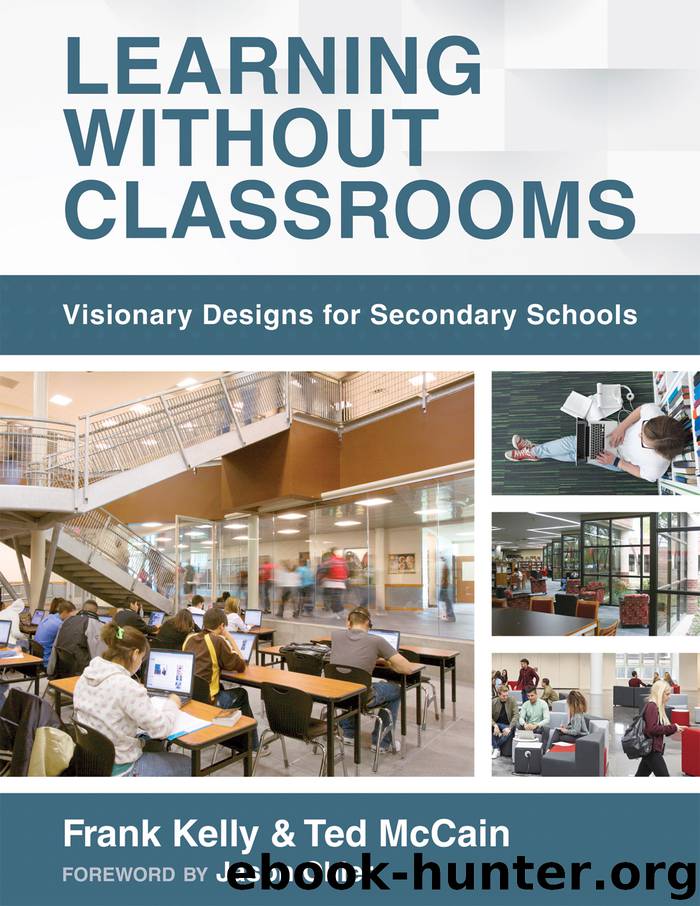Learning Without Classrooms by Frank Kelly

Author:Frank Kelly
Language: eng
Format: epub
Publisher: Solution Tree Press
Published: 2018-03-17T16:00:00+00:00
Figure 5.12: School day with individualized self-paced studies.
Advisory School Year
Just as school days require flexibility to better support students and individual learning, so too should the school year. Advisory-based schooling must be a continuous service, not a seasonal event, and schools should function twelve months a year to serve students just as hospitals are there to serve patients’ medical needs as they arise. In this model, there are no semesters or quarters. The process is continuous, punctuated only by students when they complete the learning objectives of one course and begin another. Graduation is not an annual celebration, rather students receive digital diplomas certifying they completed their studies whenever that occurs.
Consider figure 5.13 (page 82), which describes the individual studies for four students over an eighteen-month period. Each shaded bar represents a different course of study, although the exact nature of the courses in this case is immaterial.
In this example, students A and B elect to carry a light academic load to suit their learning styles or to address family or health needs. At any one time during this period, these two students are taking as many as four courses or as few as one. These students would probably need more than four years to graduate high school. Student C elects to concentrate his or her studies to take off a traditional summer period but note this student could just as easily do this at any time of the year. Student D elects to take a very intense course load with five or six courses going simultaneously all year. This student would graduate in less than four years. The potential variations are as distinct as students themselves. Some students may have to attend during certain times and to stipulated levels to be eligible to participate in extracurricular programs such as athletics. Teachers may work part of the calendar year (as with the traditional agrarian calendar) or teach all year and earn proportional compensation.
Along with the improved educational outcomes we believe this model will produce, this approach to year-round schooling also has additional benefits: distributing these activities over the year and affording families the opportunity to enjoy themselves in every season help resorts and businesses that thrive on vacationing families.
Download
This site does not store any files on its server. We only index and link to content provided by other sites. Please contact the content providers to delete copyright contents if any and email us, we'll remove relevant links or contents immediately.
| Administration | Assessment |
| Educational Psychology | Experimental Methods |
| History | Language Experience Approach |
| Philosophy & Social Aspects | Reform & Policy |
| Research |
The Art of Coaching Workbook by Elena Aguilar(51000)
Trainspotting by Irvine Welsh(21521)
Twilight of the Idols With the Antichrist and Ecce Homo by Friedrich Nietzsche(18508)
Fangirl by Rainbow Rowell(9104)
Periodization Training for Sports by Tudor Bompa(8173)
Change Your Questions, Change Your Life by Marilee Adams(7638)
This Is How You Lose Her by Junot Diaz(6800)
Asking the Right Questions: A Guide to Critical Thinking by M. Neil Browne & Stuart M. Keeley(5651)
Grit by Angela Duckworth(5525)
Red Sparrow by Jason Matthews(5392)
Paper Towns by Green John(5092)
Room 212 by Kate Stewart(5041)
Ken Follett - World without end by Ken Follett(4647)
Housekeeping by Marilynne Robinson(4349)
The Sports Rules Book by Human Kinetics(4299)
Double Down (Diary of a Wimpy Kid Book 11) by Jeff Kinney(4208)
Papillon (English) by Henri Charrière(4199)
The Motorcycle Diaries by Ernesto Che Guevara(4018)
Exercise Technique Manual for Resistance Training by National Strength & Conditioning Association(3959)
